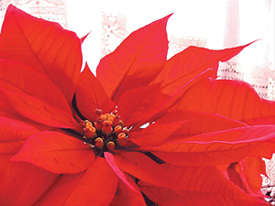December 9, 2009
Poinsettias, Traditional Blooms of the Holiday Season
 By Becky Lee Hinton
By Becky Lee Hinton
Director of Marketing
The Fountains Senior Living Community
During this time of year, one can hardly go anywhere without seeing large, glorious blossoms of poinsettias. Last year, over $220,000,000.00 worth of the seasonal potted plants were sold during the holiday season. Poinsettias are native shrubs of Mexico, Central and South America. The Aztecs called them “cuetlaxochitl” and used the red leaves to create a rich red dye for their textiles. Montezuma, a king of the Aztecs, would have caravans of poinsettias brought in to what is now Mexico City, because they do not grow in the higher altitudes. In Chile and Peru, the poinsettia is commonly known as the “Crown of the Andes.” Here in the US, we enjoy our Christmas blossoms for a few short weeks in six-inch pots. I have been very fortunate to travel through Mexico and Costa Rica, and I have seen many homes with poinsettias like shade trees as tall as second-story windows. The poinsettia’s botanical name is Euphorbia pulcherrima and literally means “very beautiful.” So, where did this very beautiful shrub get the name poinsettia?
 President John Quincy Adams appointed Joel Robert Poinsett the first ambassador to Mexico in 1820. Coincidentally, Joel Poinsett was interested in botany and often wandered the countryside in search of new plant species. He brought cuttings of many plants, including the poinsettia, back to his greenhouse in South Carolina. In spite of the fact that Joel Robert Poinsett had a distinguished career as a congressman and ambassador, we remember him today as the man who introduced the poinsettia to the United States of America.
President John Quincy Adams appointed Joel Robert Poinsett the first ambassador to Mexico in 1820. Coincidentally, Joel Poinsett was interested in botany and often wandered the countryside in search of new plant species. He brought cuttings of many plants, including the poinsettia, back to his greenhouse in South Carolina. In spite of the fact that Joel Robert Poinsett had a distinguished career as a congressman and ambassador, we remember him today as the man who introduced the poinsettia to the United States of America.
You can make your poinsettia last by keeping it in a sunny window, but be careful not to let the leaves come in contact with icy window panes. Remove the pretty foil wrapper and water when the soil is dry. Allow the soil to drain completely. Do not allow your poinsettia to sit in water. Use a water-soluble plant fertilizer once a month. Move your poinsettia outdoors to a sunny area once there is no threat of frost.
To coax your poinsettia to reflower, keep it in total darkness from 5:00 p.m. to 8:00 am beginning around October 1st. Any exposure to light may prevent the desired color change, so moving it into a closet or covering it with a light-blocking cloth with give you the best results.
With a little effort, the poinsettia you purchase this year could be bigger and more beautiful next year, and you will have the satisfaction of knowing that you helped Mother Nature along with her beauty.
Becky Lee Hinton is the Director of Marketing at The Fountains Senior Living Community. To schedule a lunch visit or your personal tour, call Becky at (563) 332-5775.
Filed Under: History
Tags: Becky Lee, Botanical Name, Coincidentally, First Ambassador To Mexico, Foil Wrapper, Inch Pots, Joel Poinsett, John Quincy Adams, Native Shrubs, Poinsettia, Potted Plants, President John Quincy, President John Quincy Adams, Red Dye, Red Leaves, Shade Trees, Story Windows, Sunny Window, Window Panes, Year One
Trackback URL: https://www.50pluslife.com/2009/12/09/poinsettias-traditional-blooms-of-the-holiday-season/trackback/


